In this article, we delve into the tactical mastery of Fabian Hürzeler at FC St. Pauli. Under Hürzeler’s guidance, St. Pauli has transformed into a formidable side, characterized by innovative strategies and cohesive teamplay. We will explore the key tactical elements that define their game, from formations and player roles to in-game adjustments and strategic nuances. Join us as we dissect the tactical blueprint that has propelled St. Pauli under Fabian Hürzeler’s leadership, offering insights into the principles and decisions shaping their success on the pitch.
Build-up
Low Build-up
1-4-2-2-2
Fabian Hürzeler usually sets his team up in a 1-4-2-2-2 formation in the low build-up. They use two dropping number-tens and two wingers, looking to attract opposition players, opening up the space in behind.
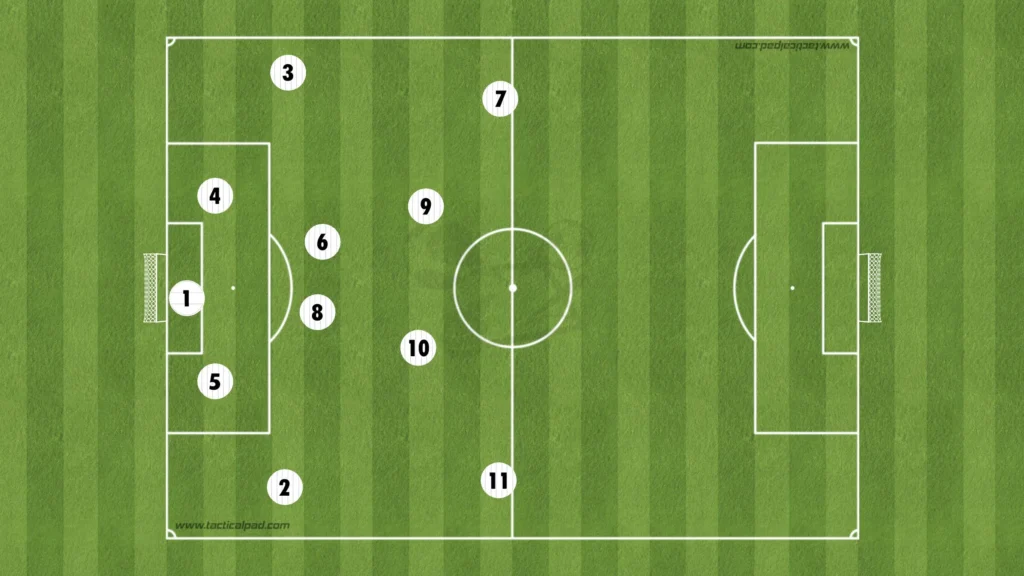
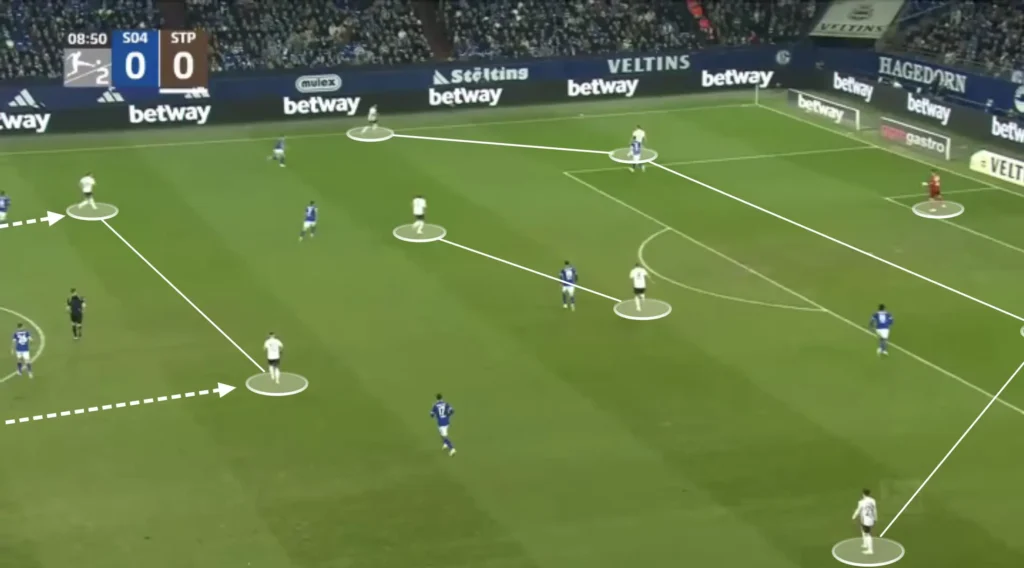
This formation, popularized by Roberto De Zerbi, questions the opposition center-backs, forcing them to make difficult decisions. If they push up on the number-tens, the space behind them opens up, giving the winger a 1v1 against the fullback.
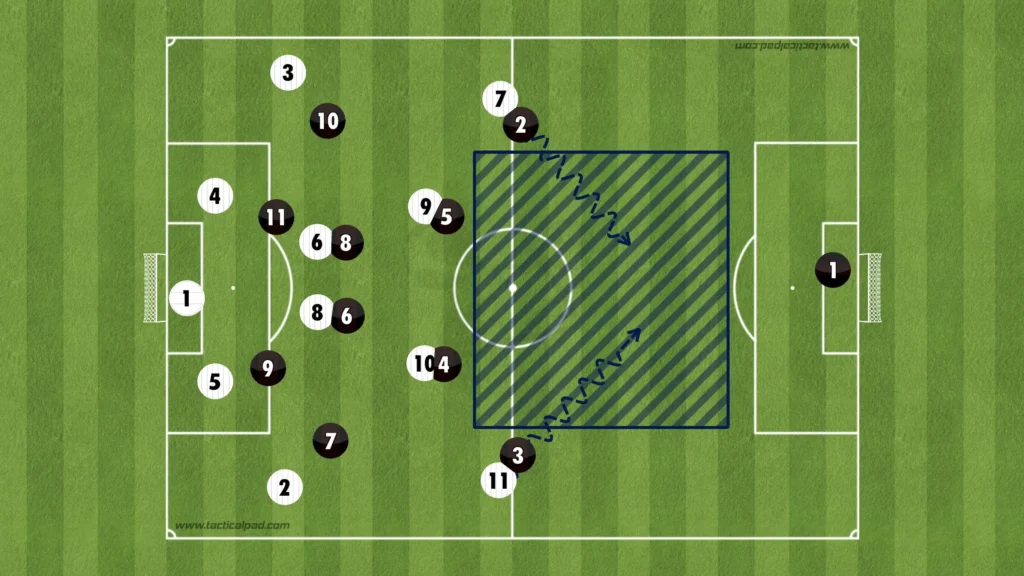
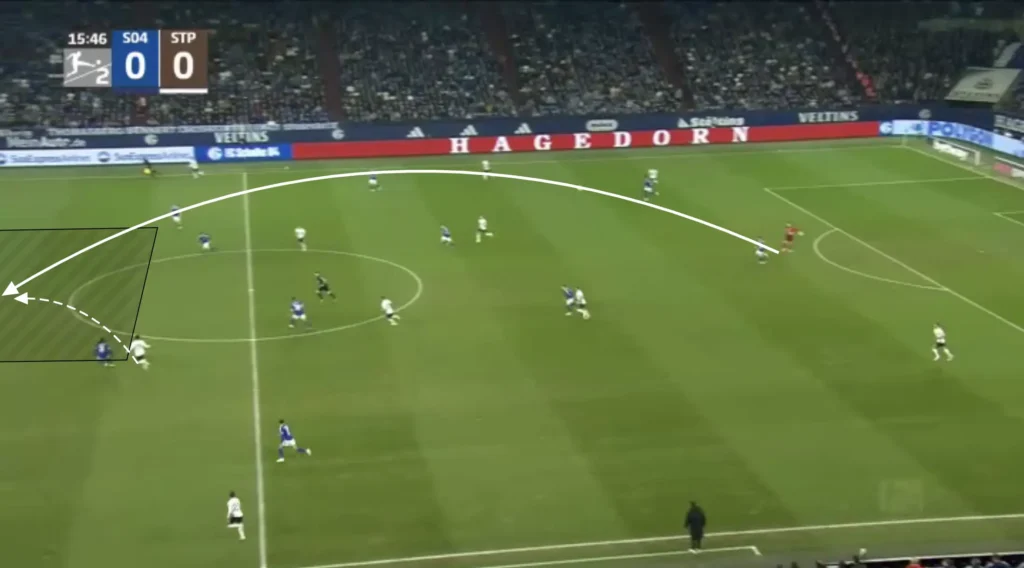
However, If they do not push up, a numerical superiority gets created in the midfield, allowing St. Pauli to play through the press.
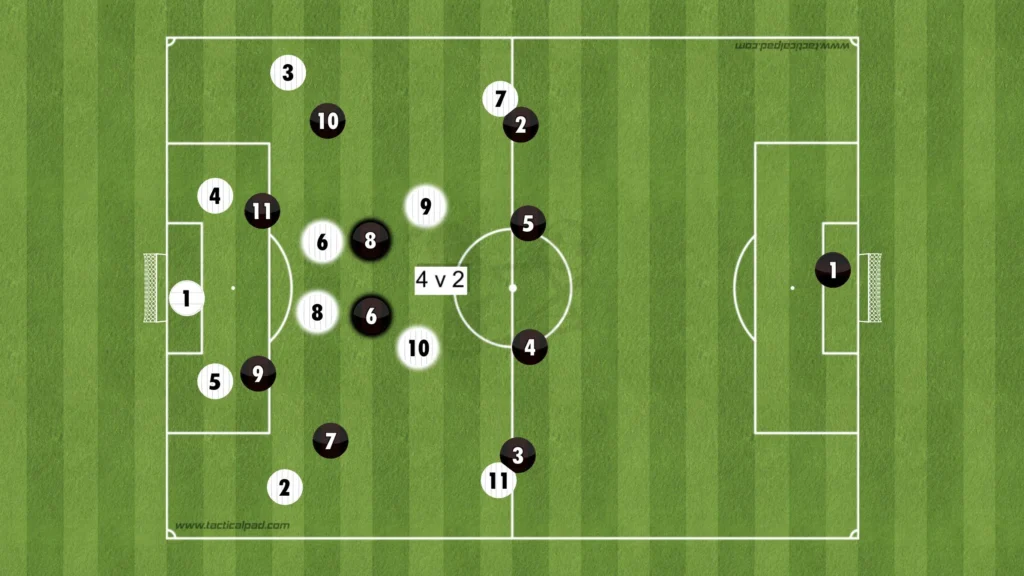
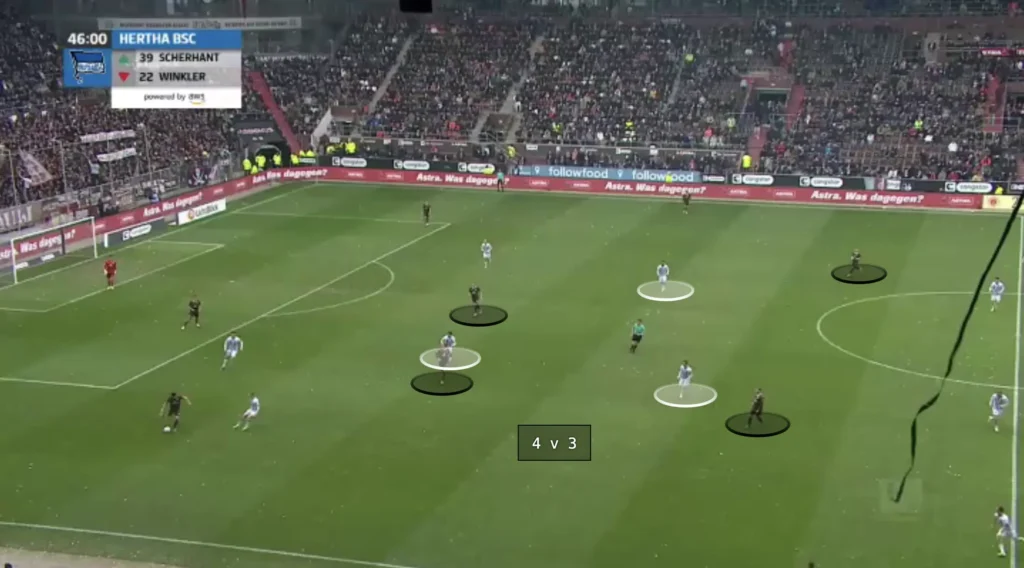
1-4-1-5
Hürzeler has also used a 1-4-1-5 formation in the low build-up during this season. The attacking midfielders will be very high and the number-six will be low, which opens big spaces in the midfield.
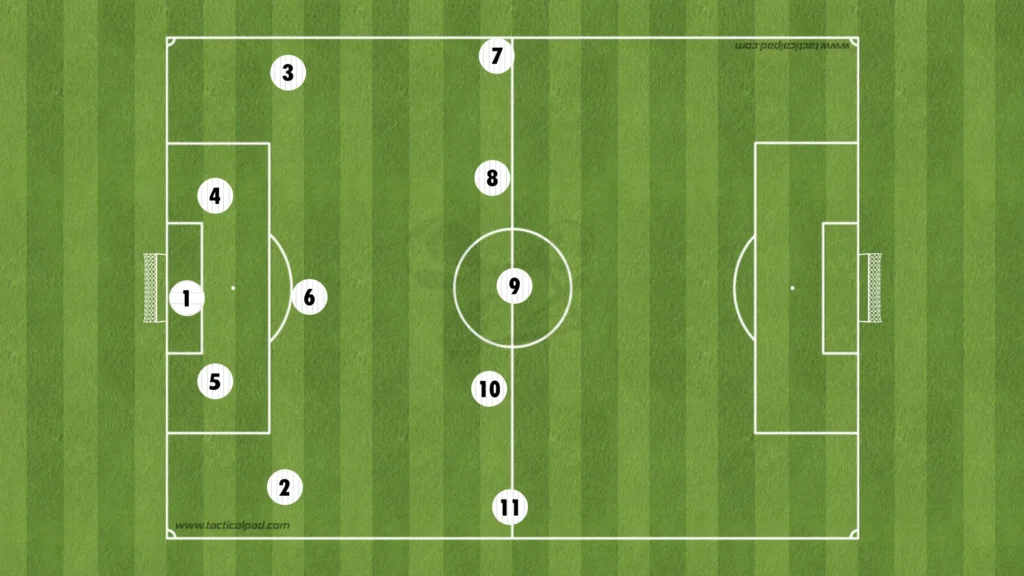
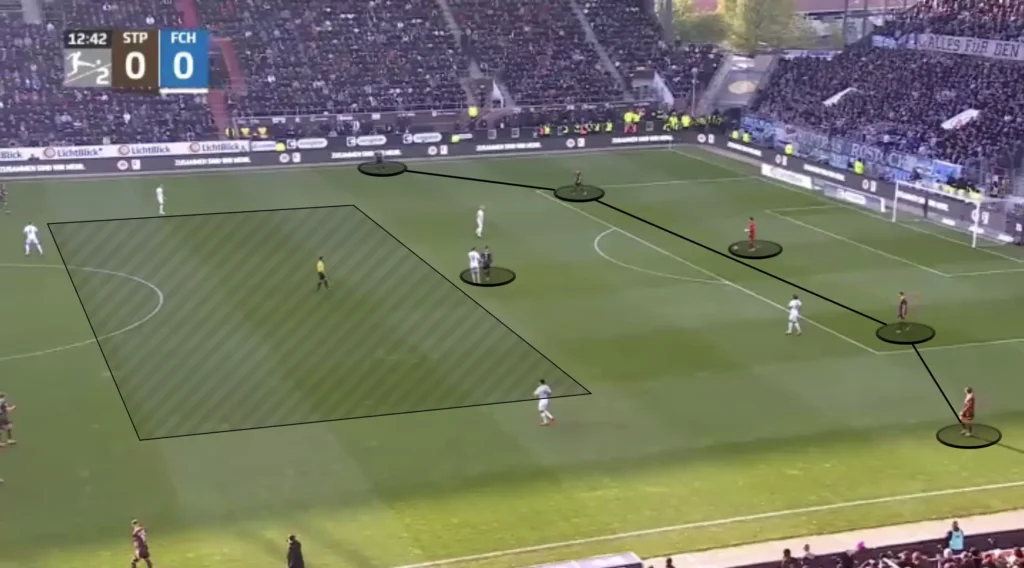
The attacking midfielders often drop down into these spaces to either receive the ball and turn, or find a pass to the winger or number-six.
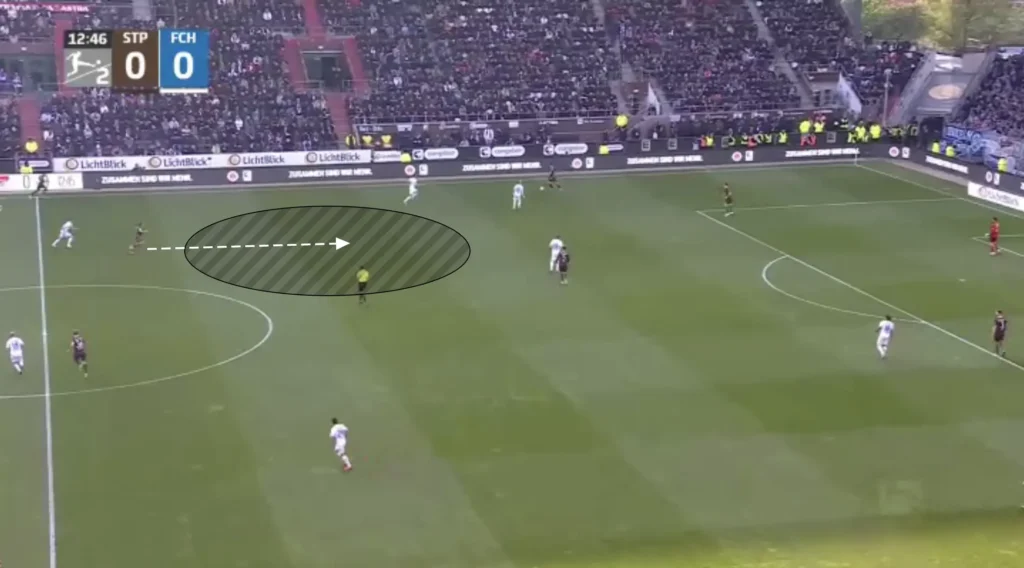
The St. Pauli fullbacks will also come into these spaces to receive the ball and progress the play forward. The opposition wingers will rarely follow these runs into the midfield, which means the fullback will have the time and space to take the ball forward.
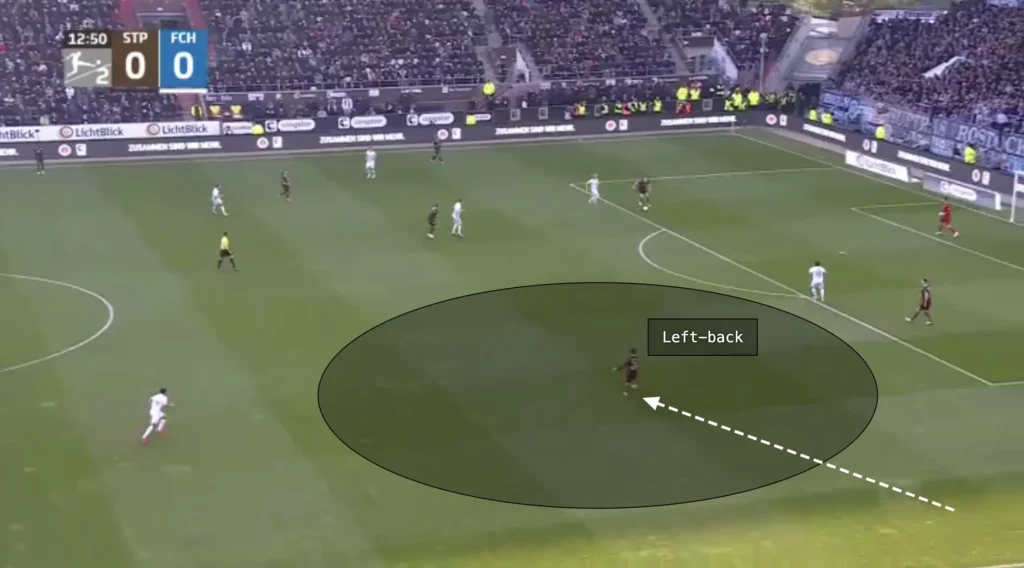
High Build-up
In the high build-up, Hürzeler has used many different formations. Their most frequently used formations have been a 1-3-2-5 formation;
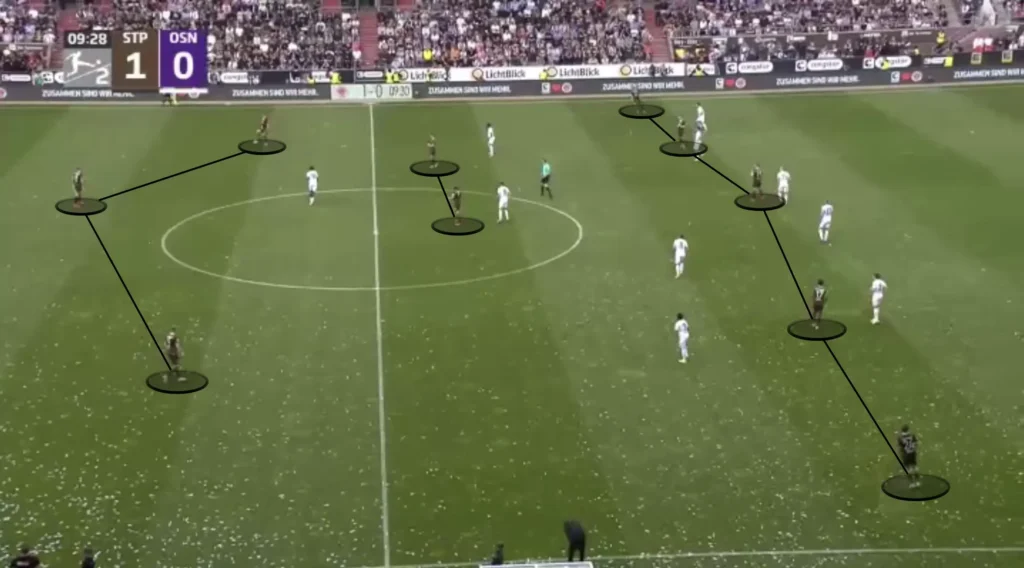
Or a 1-2-3-5 formation:
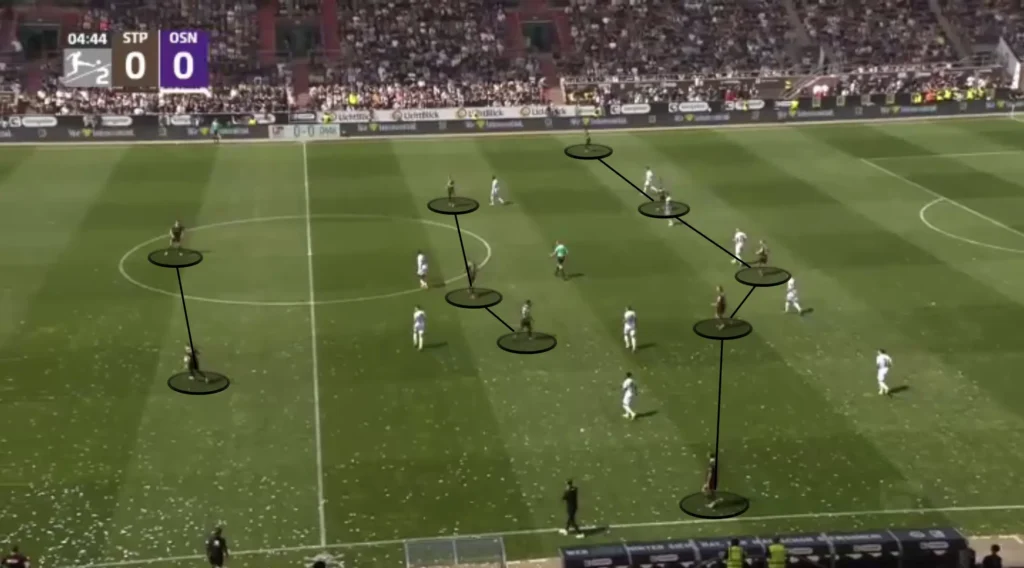
St. Pauli will always have many players in the center, regardless of the formation. This creates more options in the center and less space between the players. Hürzeler likes this because he prioritizes playing through the middle. He needs one player high and wide to pull apart the backline while the rest create numerical advantages in the midfield areas. This builds good conditions in defensive transitions, allowing more players to press when they lose the ball. Another purpose for keeping many players in the middle is to shorten the distance between them. This shortens the length of the passes, which naturally shortens the time between passes. This means the opposition players will have less time to push up and press, giving the St. Pauli players more time and control.
Controlling the Game
An important principle in Hürzeler’s playing style is to control the tempo of the game. St. Pauli are masters at changing the tempo with a few quick passes, beating the lines of the opposition after having the ball for a long time.
One tool that helps control the game is for the center-backs to stand still with the sole on the ball.
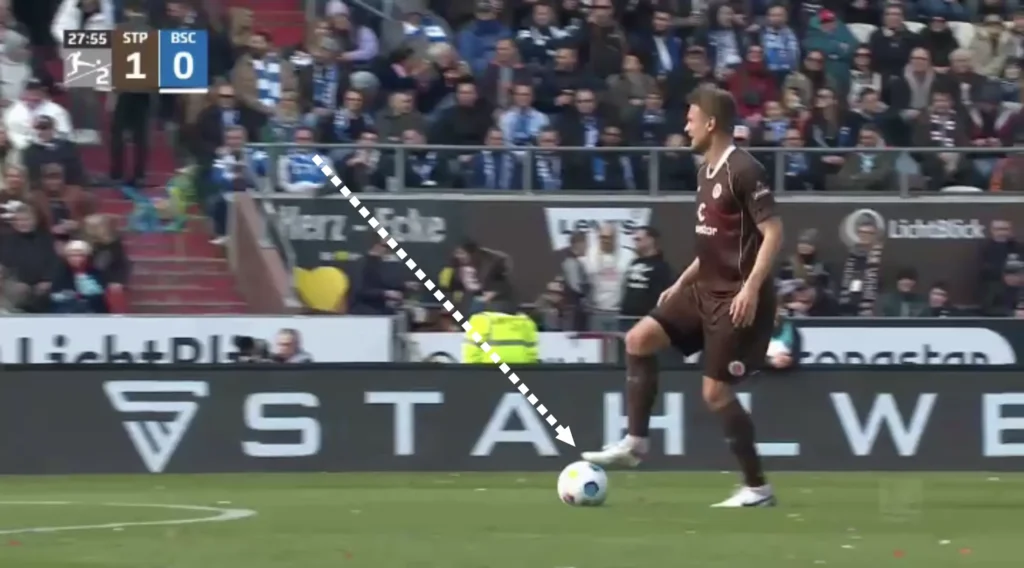
They do this for two reasons:
1.) It enables the center-back to play the ball to either side.
2.) It lures the press while still having control of the ball.
High Backline
A massive aspect of Hürzeler’s high possession build-up is they keep a high backline. This helps in the counterpress because they get closer to the center. Having more players close to the center who can win the ball back makes it difficult for the opposition to do anything when they win possession. Furthermore, the high backline shortens the distance between players, shortening the time and length of the passes and preventing the opposition from pushing up their defense.
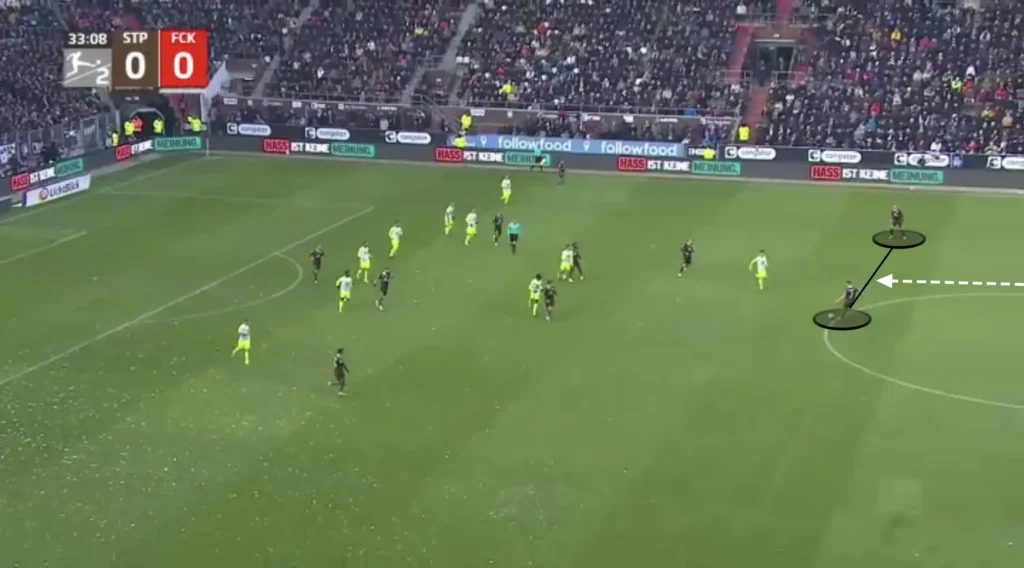
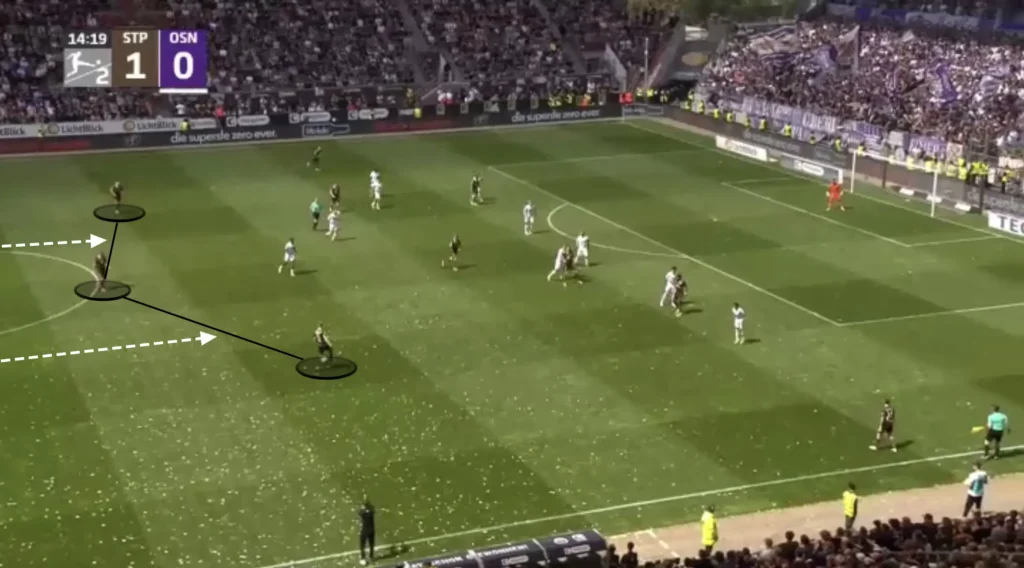
Linking with the Striker
Fabian Hürzeler likes to create central overloads when attacking the opposition. Therefore, the St. Pauli striker often drops during the build-up. When the striker drops, they unlock more ways of beating the opponent’s defense. They can pass the ball to the striker, who can find an attacking midfielder in the pocket or play a one-touch pass out to the winger.
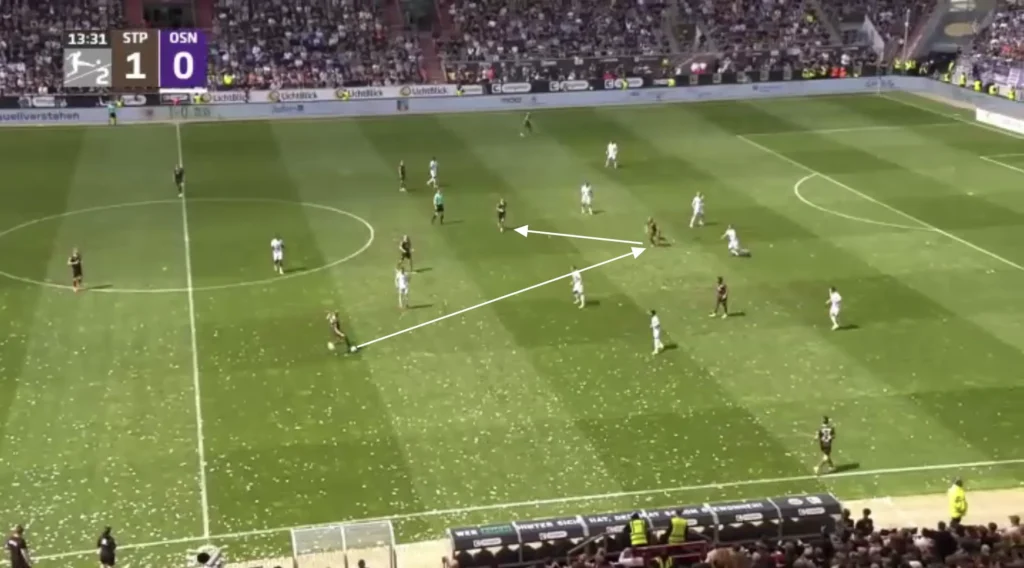
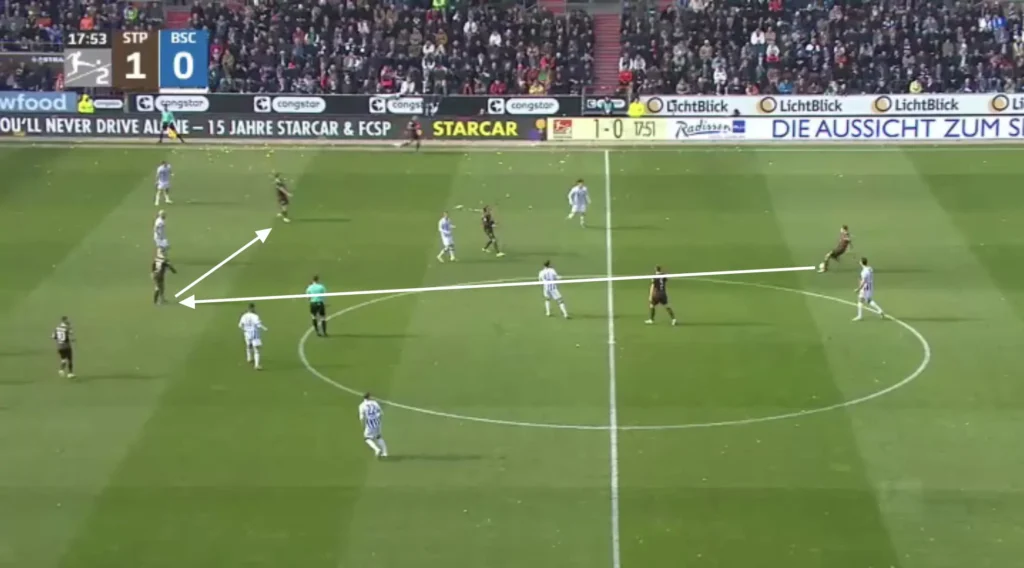
If the center-back pushes up on the striker, the space in behind opens up. When that happens, St. Pauli will exploit the space in behind with runs from the attacking midfielders.
Finding the Pockets
St. Pauli always try to find the attacking midfielders in the pockets. Their midfield numerical superiority usually means that at least one will be open. They will look for passes from the backline, breaking lines and finding an attacking midfielder who will turn and drive at the defense.
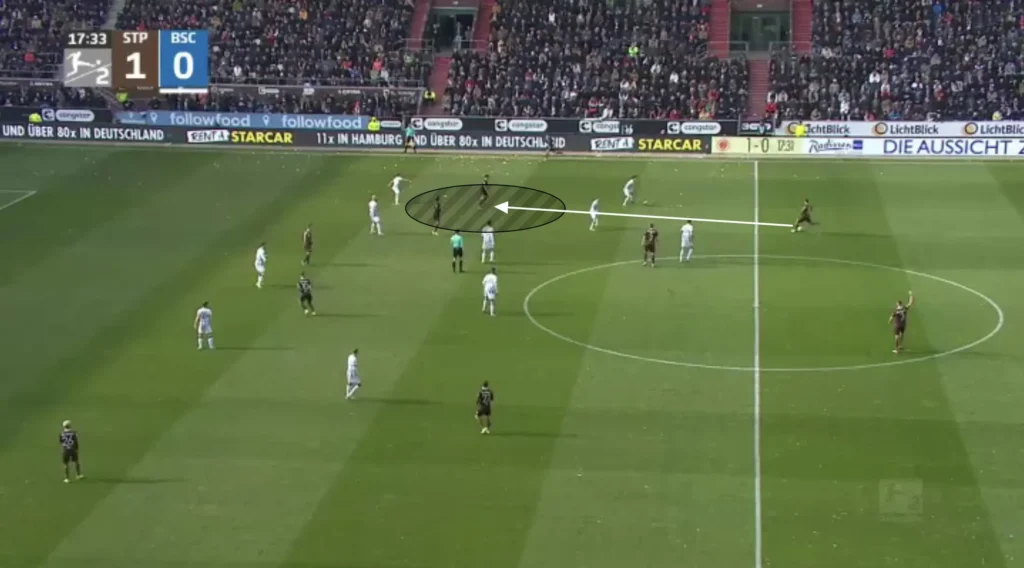
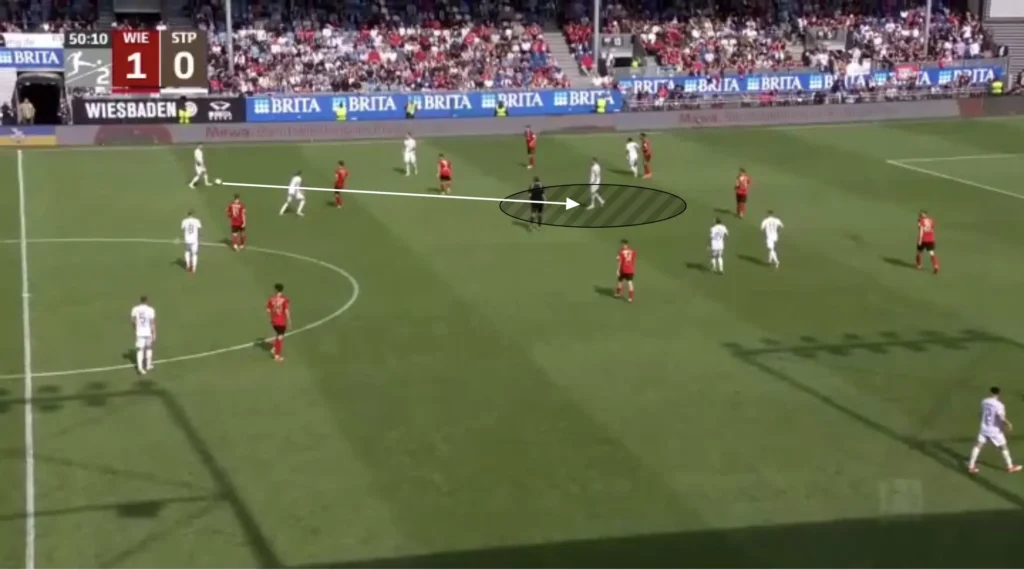
Runs in Behind
The St. Pauli attackers and sometimes midfielders constantly make runs in behind when the defenders have the ball. This constant threat prevents the opposition from playing with a high backline and closing the space between the lines. Instead, they have to drop the backline and protect the space in behind. This opens the space in front of the backline for the other St. Pauli midfielders to exploit.
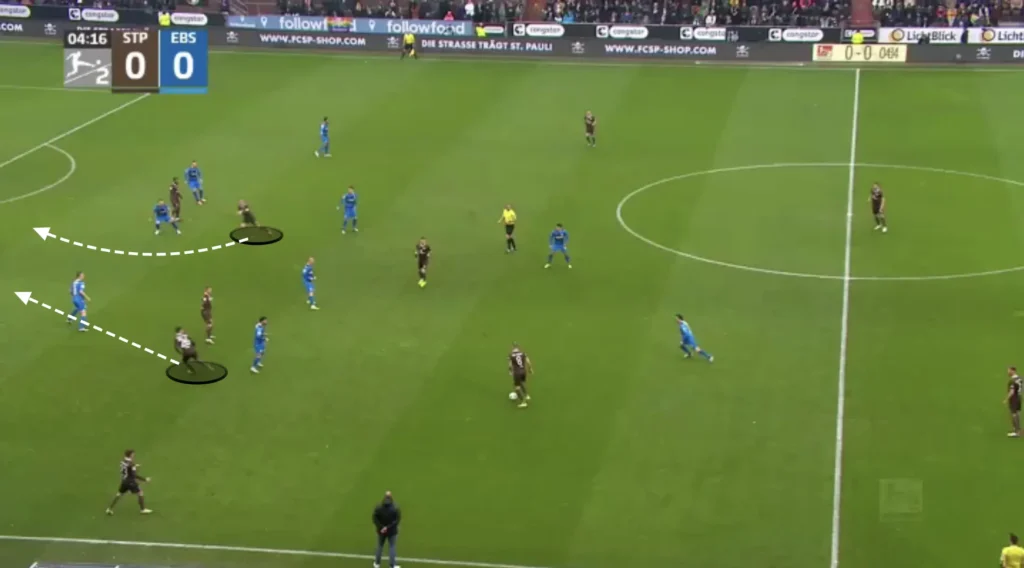
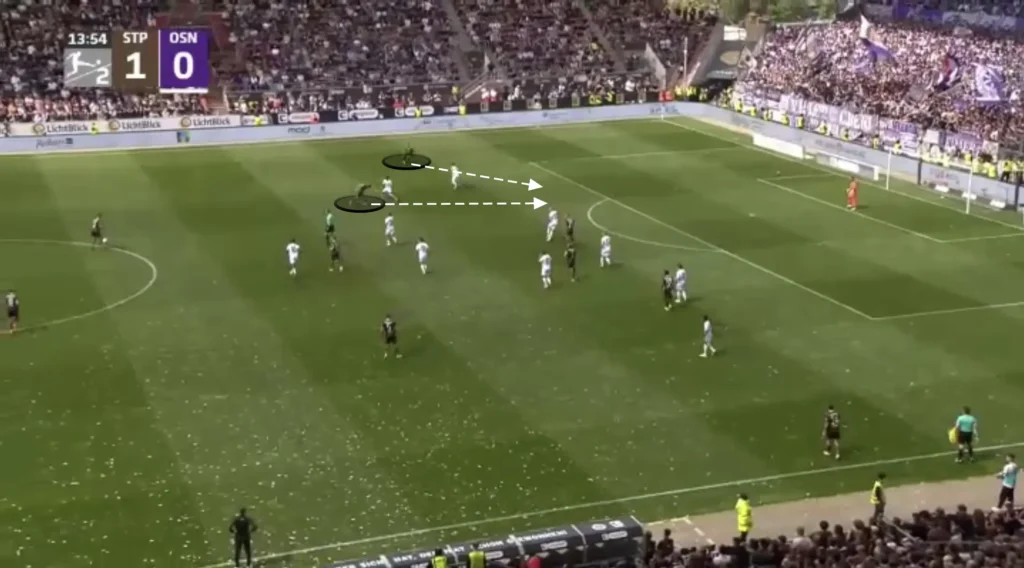
Numerical Advantages
Another massive aspect of St. Pauli’s high build-up is their ability to create numerical advantages against the opposition’s defensive line. Their front five naturally becomes numerically superior against the opposition’s backline, which they are great at taking advantage of.
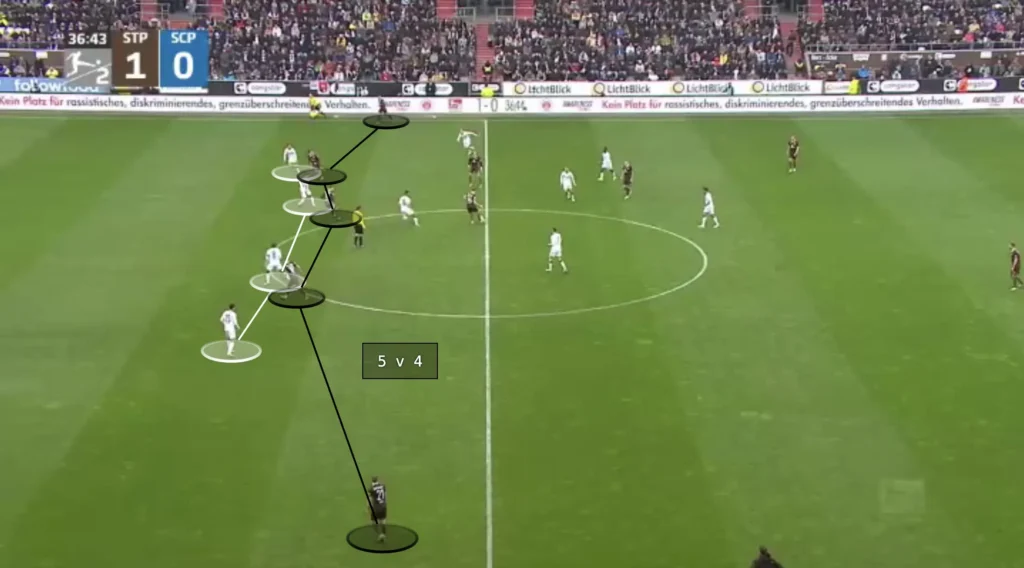
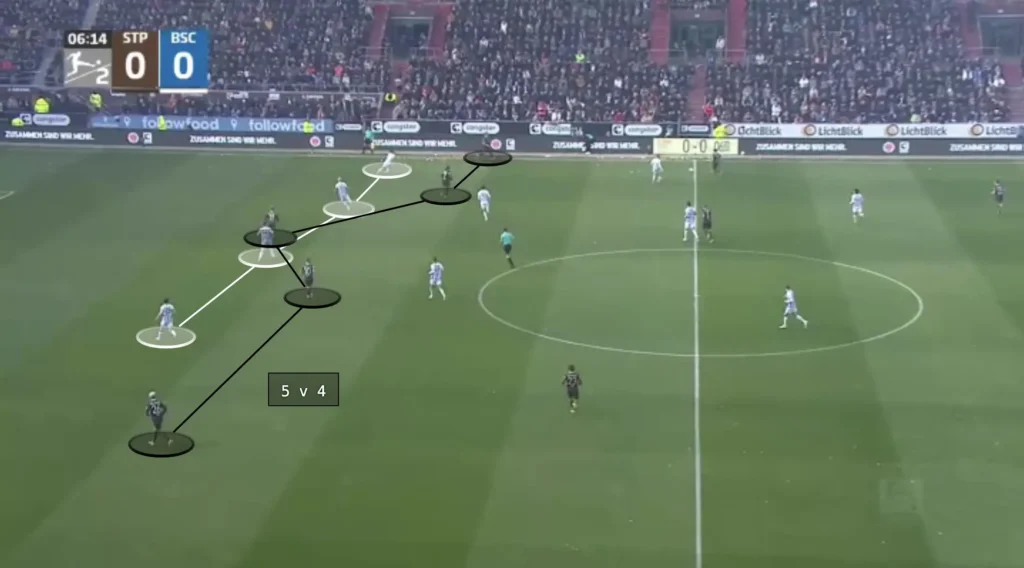
For example, when the defending team is positioned on one side, the weak-side fullback becomes vulnerable to the long switch of play due to the 1v2 against St. Pauli’s winger and attacking midfielder. The attacking midfielder will make a run in behind, the fullback will follow that run, and the space for the winger out wide will be opened. Hürzeler’s team often capitalizes on this by getting the ball to the winger and creating many opportunities from 2v1 situations on the wing and in the half-spaces.
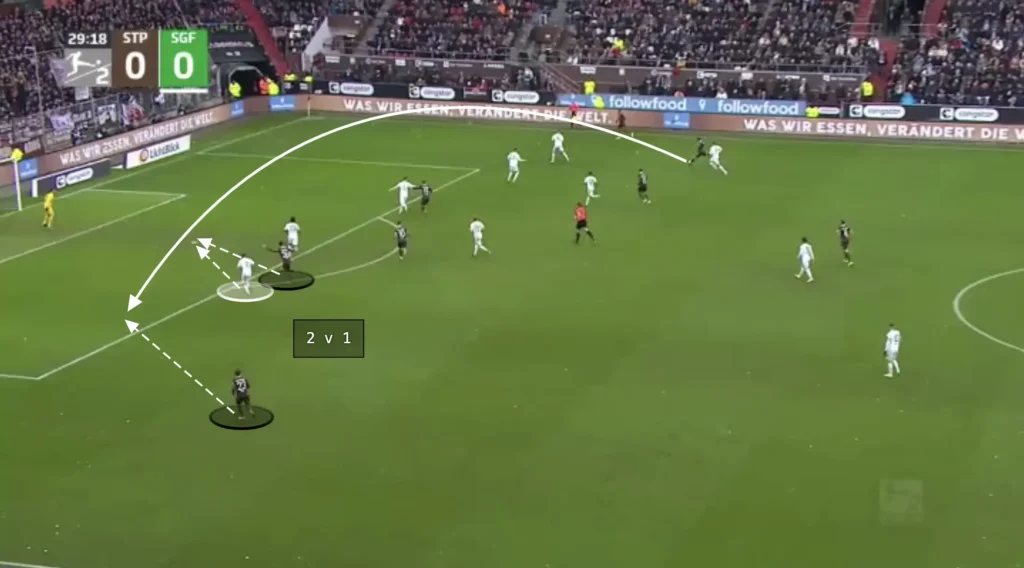
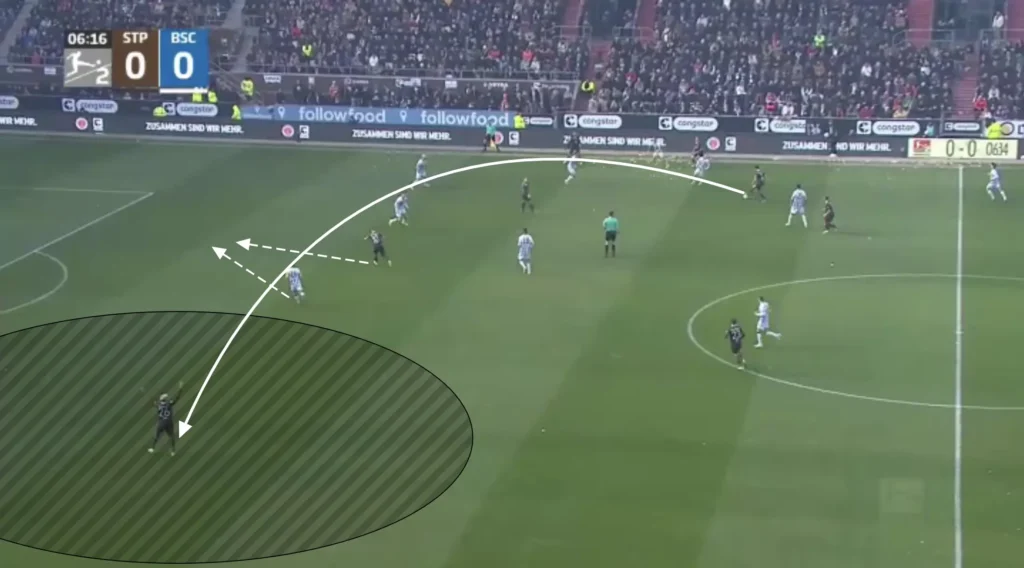
If the fullback does not follow the run from the attacking midfielder and instead closes the space for the winger, the attacking midfielder will be completely open. He can receive a through-ball in behind the backline, giving him a 1v1 against the goalkeeper.
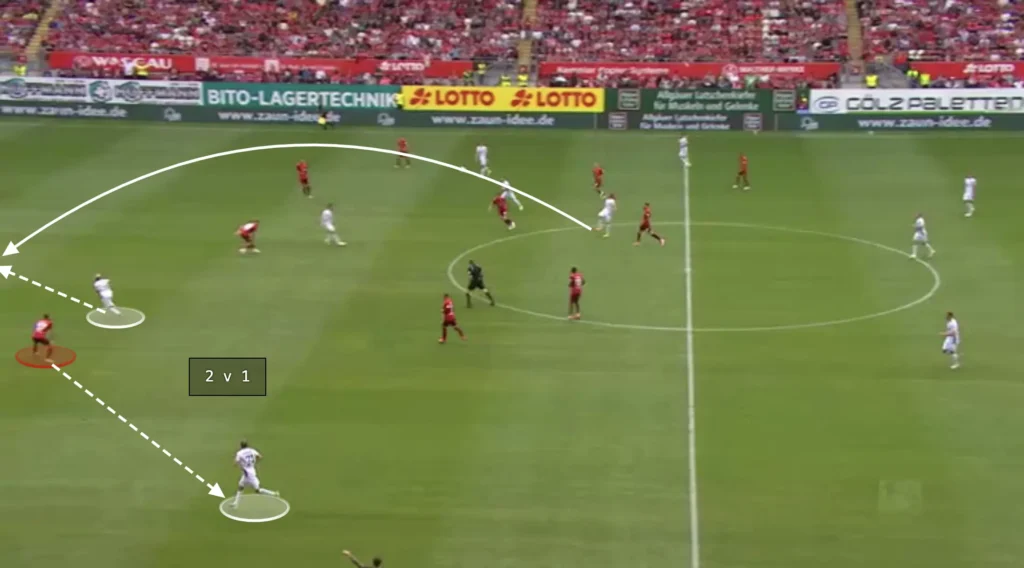
The constant runs in behind from the midfielders and attackers also means that St. Pauli often get more players into their forward line, in this case being 7v4 against the opposition backline.
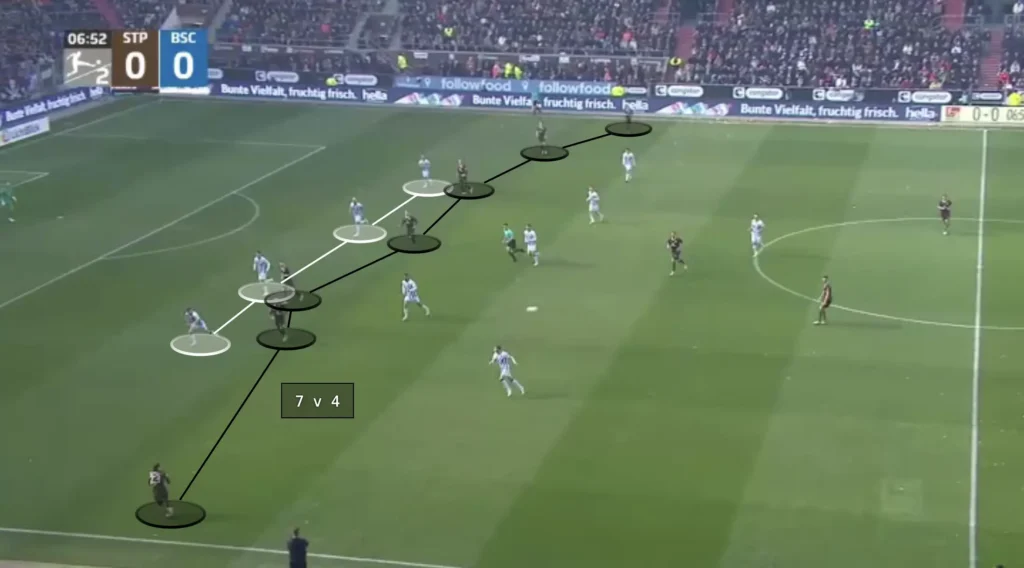
When this happens, St. Pauli will look to find their wingers and play fast crosses into the box, where they will be numerically superior.
Final Third
Attacking the Half-Space
Hürzeler’s teams usually look to create chances by attacking the space between the opposition center-back and fullback. They primarily do this from the wide areas with underlaps from the attacking midfielders. When the winger receives the ball he will attract the opposition fullback. This opens the space between the fullback and the center-back, which allows the St. Pauli attacking midfielder to make the underlapping run into this space. The ball can be played to the attacking midfielder, who can cross the ball into the box or attack his defender in a 1v1 situation.
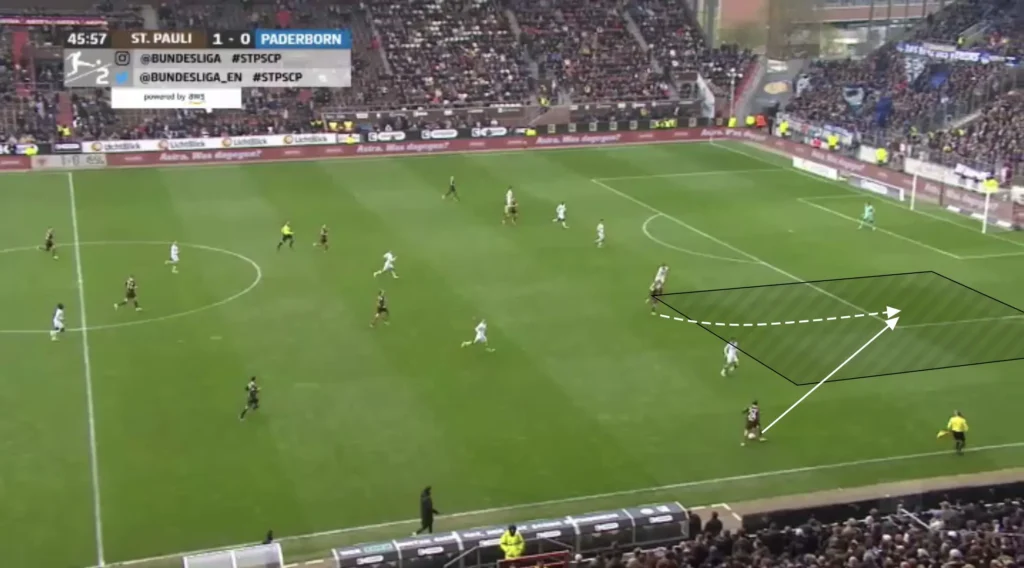
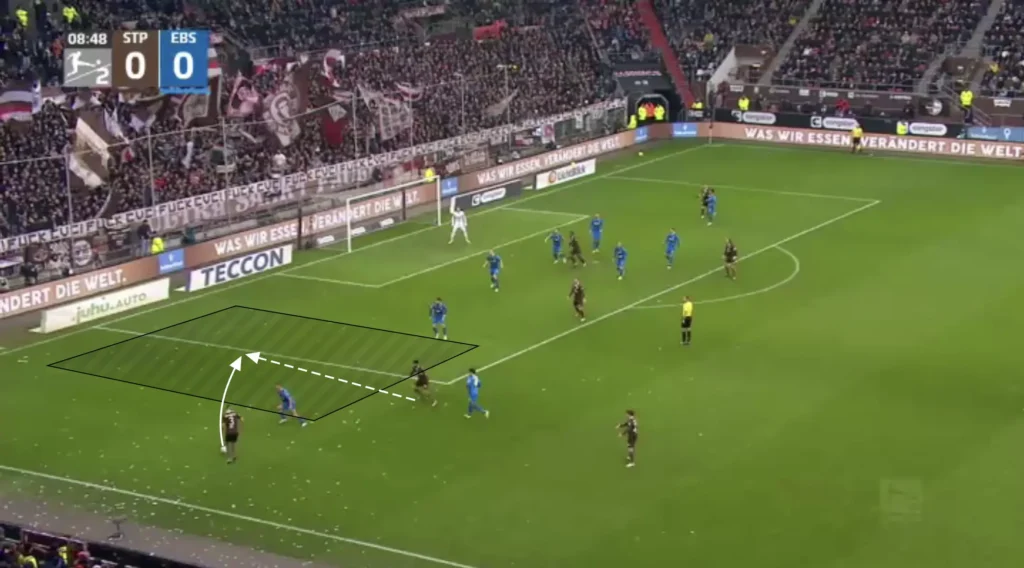
The winger does not have to play the ball to the underlapping player. The underlapping player will often drag away a defensive midfielder, which opens the space inside. The winger can take the ball inside and shoot or find a pass to a free player in front of the backline.
Many Players in the Box
The attacking midfielders and wingers look to make runs into the box when the ball is in the final third, often getting four or five players into these areas to create overloads. The numerical advantages in the box force the defending team to make decisions and leave some players open.
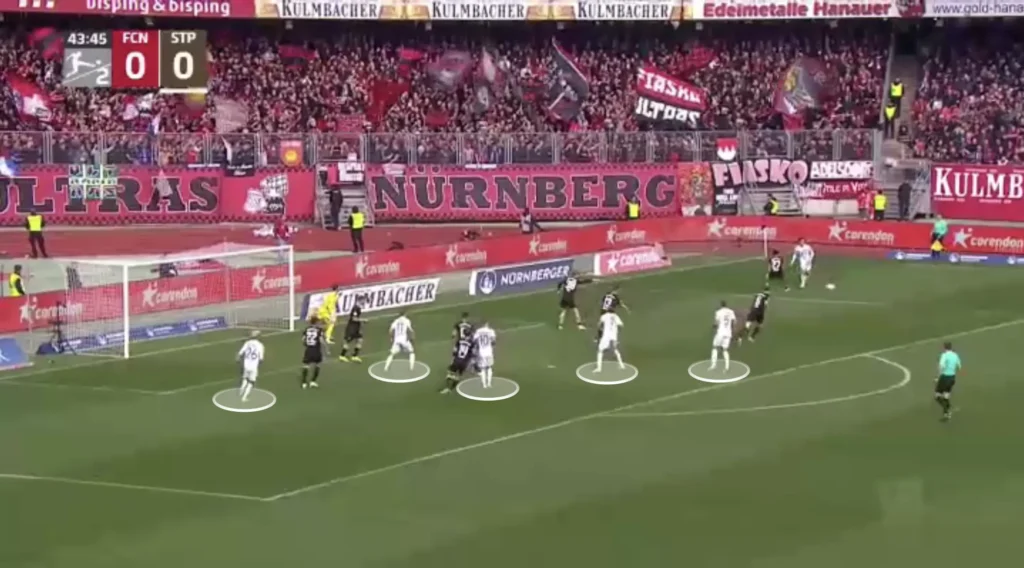
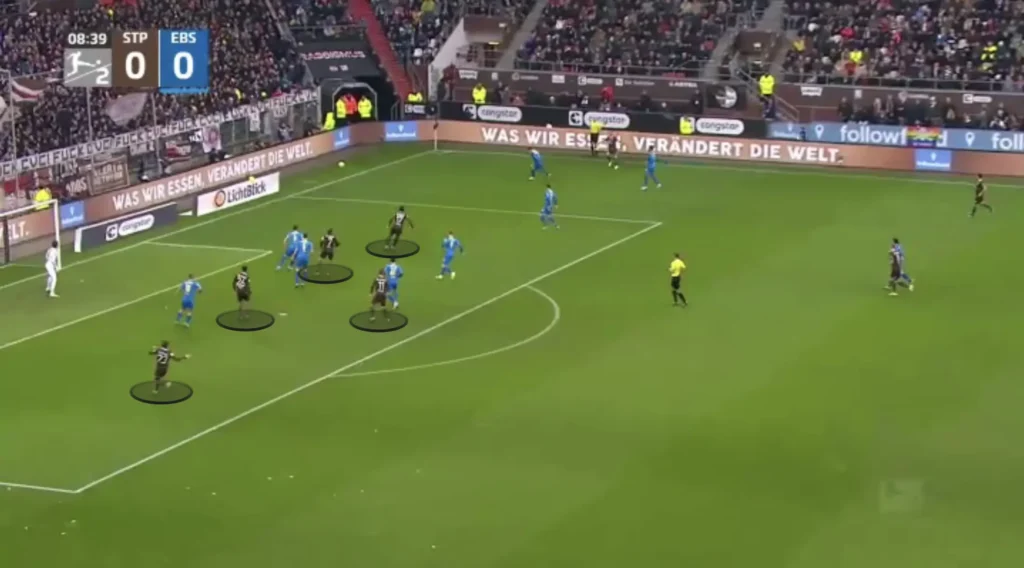
Hürzeler also positions many players outside the box, ready for the second balls and cut-backs. They always succeed in pushing down the opposition’s defense, which opens the space in front of the backline. The midfielders will often be found in these spaces with cut-backs, and from there, they can shoot or combine with an attacker to create goalscoring opportunities.
Defending
High Press
Hürzeler places much value on being aggressive without the ball. This shows in St. Pauli’s high pressure. Hürzeler usually wants his team to go man-to-man and intensely press the opposition. They almost use their high press as an attacking threat, scoring many goals from winning the ball high up the pitch.
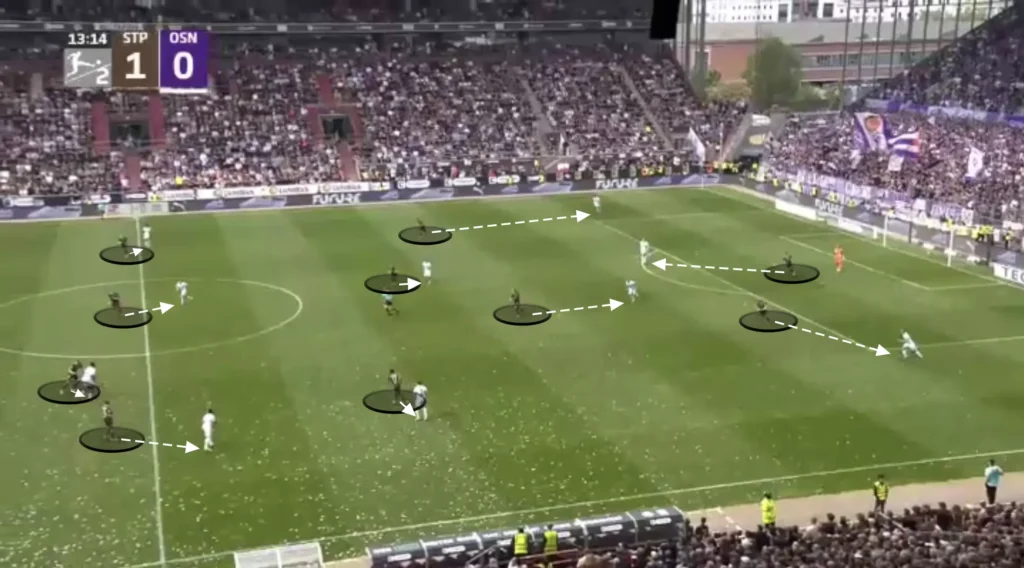
Low Press
In the low press, Hürzeler’s St. Pauli sets up a 1-5-2-3 formation. They look to be in a mid-block, always trying to stay compact, closing the center and forcing the opposition out wide.
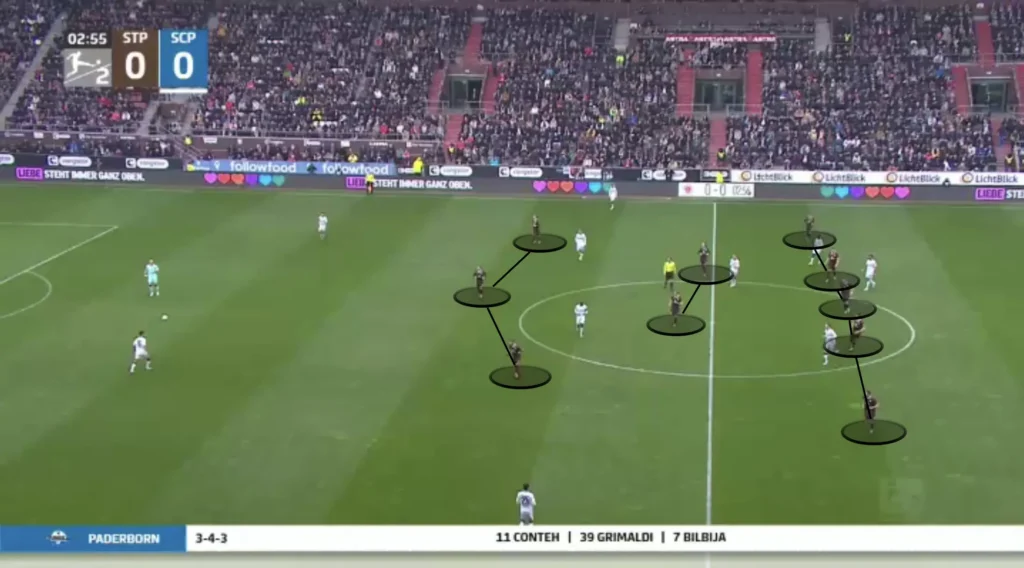
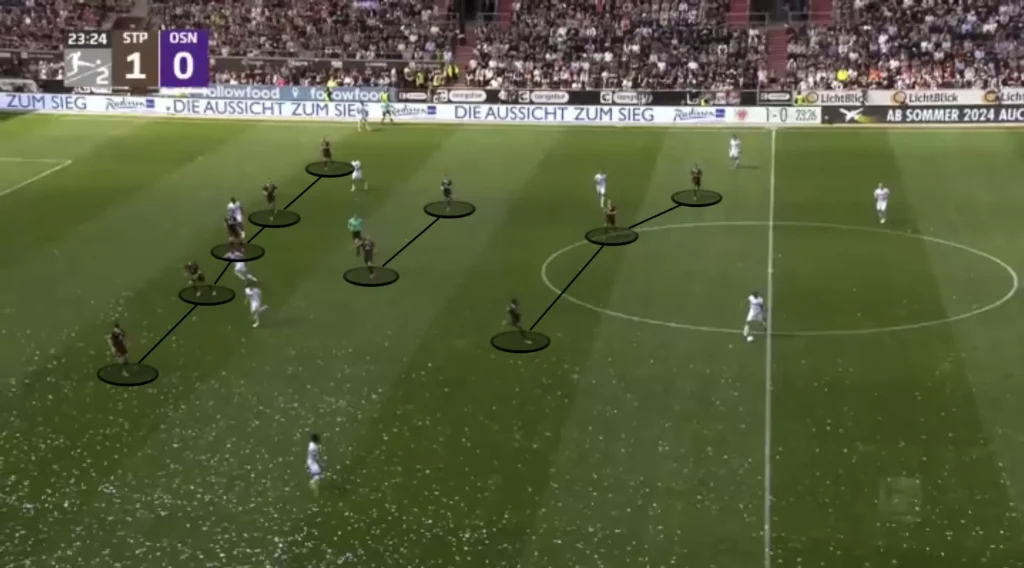
High Backline
One tool that helps to be compact is to play with a high backline, making the space to the midfield line as small as possible. St. Pauli do this and usually try to keep the highest line they can without leaving the space behind them too open. Defending with a high backline involves positioning the defensive line closer to the midfield, rather than near the goalkeeper. This tactic compresses the space available for the opposing team to operate, disrupting their build-up play and increasing the chances of winning the ball back quickly.
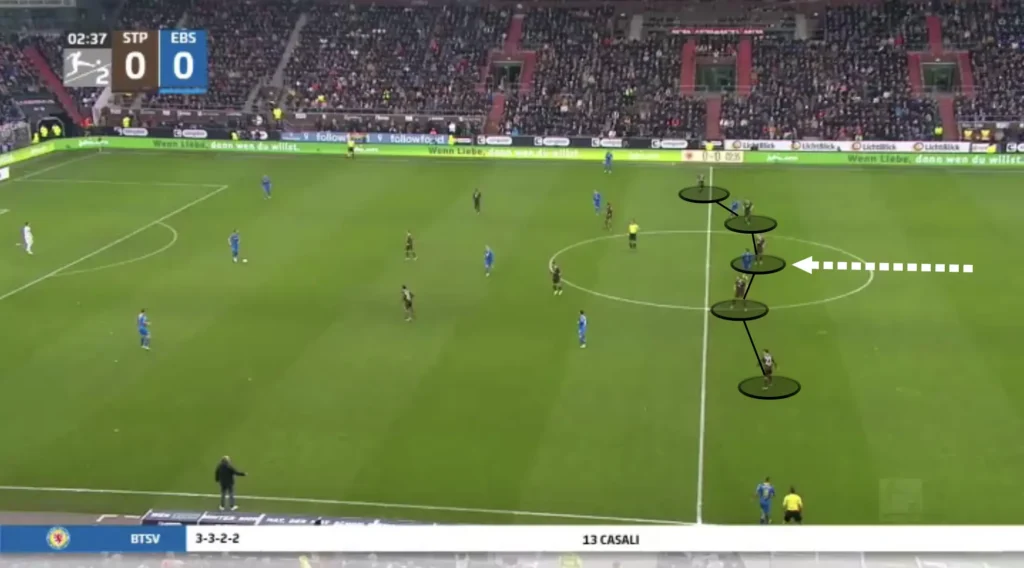
Everyone must be in the same line when defending with a high backline to maintain an effective offside trap, ensure cohesive coverage, and reduce gaps that attackers can exploit. A well-aligned defensive line makes it easier to catch opposing forwards offside, preventing them from receiving the ball in dangerous positions.
Another crucial detail that Hürzeler focuses on is the defender’s body position. He wants them to play side-on, being ready to run both forward and backward. Tracking the run in behind is more difficult when facing forward than if you play side-on. If you are facing forward, you have to turn your entire body before starting to run. Playing side-on gives a quicker reaction time, enabling faster movement in both directions.
Squeezing the Pitch
Fabian Hürzeler always wants his team to squeeze the pitch when defending. This means constantly pushing the team up as much as possible. Every time the opponent plays a slow, sideways pass or a back pass, St. Pauli’s first line of pressure pushes up, with the rest of the team following to stay compact. When the next pass comes, they push up even more, forcing the opponent back even more. They do this because it pushes the opponent further away from the St. Pauli goal, making it harder to create chances.
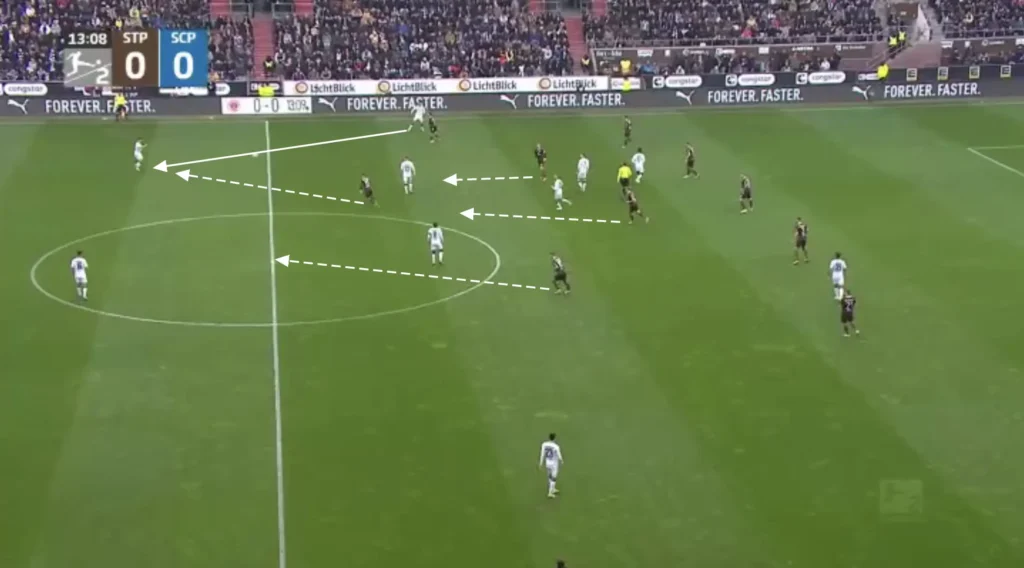
Defensive Transitions
Positioning many players centrally, creating a numerical advantage in the midfield, creates good conditions in defensive transitions. Many players close to the ball after losing possession means that many players can work towards regaining possession. Hürzeler’s players are also very aggressive in the first seconds after losing the ball. The four or five players closest will immediately jump on the opposition player with the ball and close the distance to cut off any passing lanes. Hürzeler’s team, therefore, often regains possession directly after losing it.
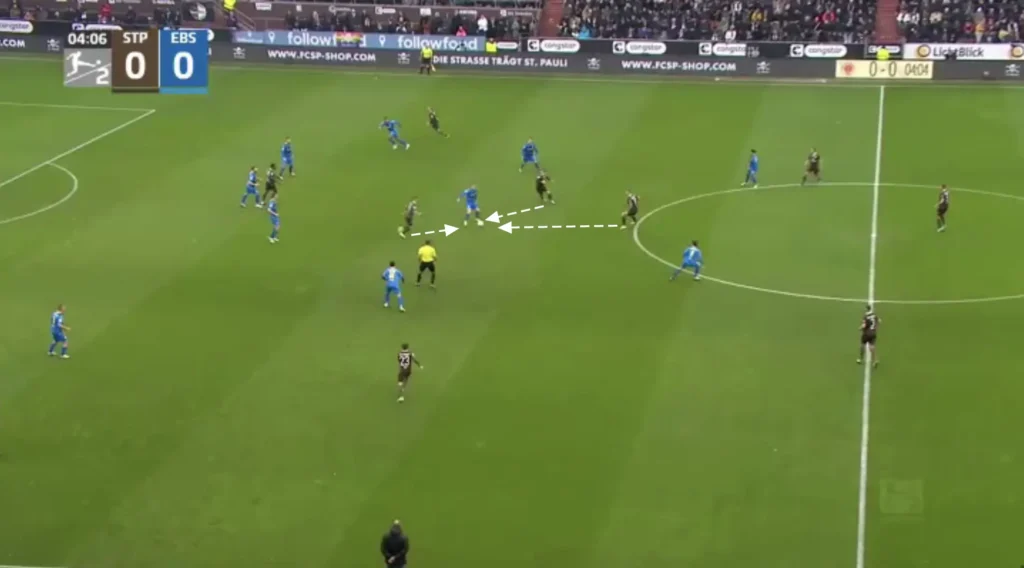
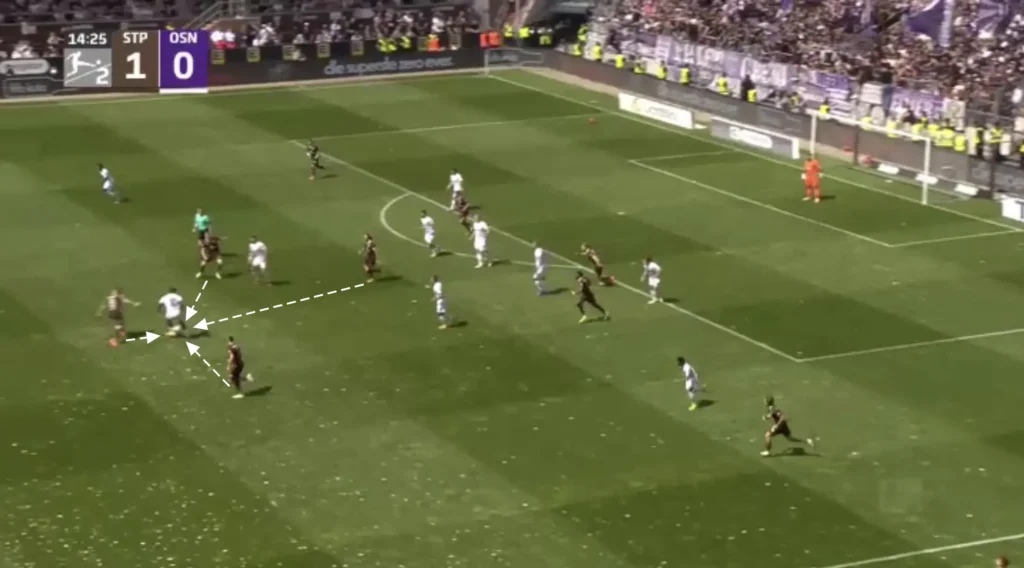
Final Thoughts
In conclusion, our tactical analysis of Fabian Hürzeler’s approach at St. Pauli highlights a blend of innovative strategies and disciplined execution. Hürzeler’s ability to balance offensive creativity with defensive stability has been key to the team’s performances. His use of flexible formations and emphasis on pressing high up the pitch demonstrate a clear vision and a modern footballing philosophy.
St. Pauli’s success under Hürzeler can be attributed to his meticulous attention to detail and adaptability in various match situations. The team’s tactical awareness and cohesive unit play are a testament to his effective coaching methods. With seemingly bigger things ahead for Fabian Hürzeler, his managerial evolution will be an exciting journey for fans and analysts alike to follow.
